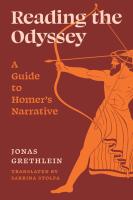
Princeton (2024) h/b 314pp £30.00 (ISBN 9780691182490)
The Odyssey is one of the earliest works of Western literature, yet its awareness of the subtleties and possibilities of narrative structure are already remarkable. In this stimulating book, G. examines the role of narration within the poem— both the overarching narrative of the epic itself and the ‘first person’ accounts of some of its characters. Underlying his discussion is a certainty that the epic as we have it is essentially as Homer composed it—a brief but satisfactory discussion of the ‘Homeric Question’ early in the book is reinforced in later chapters by examples of ways in which the poet binds the entire work together.
For example, popular assemblies and conversations between gods occur in both book 1 and book 24, creating a double ring structure of the type beloved in the Archaic Age. Yet, while book 24 (whose authenticity is sometimes doubted) ties up important loose ends, it leaves the story tantalisingly unresolved (Odysseus, we know, still has a challenging future, compelled to travel inland to a place where the sea is unknown)—just one example of the poem’s sophistication. G. explores many others, too, on both a macro and a micro level, from the ways in which the Cyclops episode mirrors Odysseus’ own slaughter of the suitors to how, in both Homeric poems, repeated (but far from formulaic) phrases serve as clever shorthand to highlight sometimes ominous echoes (in the Iliad, a running bath always presages a hero’s death, as does the phrase ‘come home from the fighting’).
G.’s primary focus is narration in the Odyssey, itself ‘a narrative about narrating’ containing a multitude of first-person tales of varying degrees of truthfulness and revealing complex relationships between narrative and experience, all of which turn out to be carefully moulded to suit the needs and expectations of their listeners. (He suggests this may even be true of the poem as a whole—a fruitful topic for future researchers versed in phenomenology and cognitive sciences.) His structure follows that of the epic itself, beginning with the Telemachy, more a rite de passage than a Bildungsroman (though some readers may think that, in suggesting that the drug with which Helen soothes Menelaus is actually … her use of narrative, G. stretches his argument to breaking point), moving on to the Apologoi (Odysseus’ autobiographical account of his adventures, which sees him crucially consolidating his identity and experiences in order to regain his sense of identity before his homecoming to Ithaca—G.’s discussion of structure and symmetry is excellent), and relishing the Return and Mnestorophony/Slaughter of the Suitors (books 13–24) with their rich seams of narrative variety. Along the way G. has time for intriguing digressions including a stimulating discussion of early vase paintings depicting episodes from the poem (the Cyclops scene predates others by almost a century) and considerations of how the Odyssey reflects Greek society, experience and attitudes in a period of geographical expansion. While some classicists may find the final chapter looking at Primo Levi’s debt to the Odyssey less useful, they will surely value G.’s insights into aspects as diverse as the poem’s views on ethics and religion, its layers of subtlety and complexity, and the brilliance of the Homeric imagination.
With one map, 19 black and white illustrations, footnotes, a good bibliography and index this is a worthwhile addition to the library. While it is eminently readable, however, it is an English translation with occasional eccentricities, and readers might be surprised to discover Aeolus binding winds in a hose and Zeus storing mankind’s fates in barrels.
David Stuttard
